CP91110P: A Computationally Designed Multi-Epitope Vaccine Candidate for Tuberculosis via TLR-2/4 Synergistic Immunomodulation
Simple Summary
Abstract
1. Introduction
2. Materials and Methods
2.1. Antigen Selection for MTB Vaccine Development
2.2. Identification and Selection of Immunodominant Helper T Lymphocyte (HTL) and Cytotoxic T Lymphocyte (CTL) Epitopes
2.3. Screening of Linear B-Cell Epitopes
2.4. Construction of Multi-Epitope Vaccine (MEV) Candidates
2.5. Biological Characterization of MEV Candidates
2.6. Physicochemical Properties and Solubility Assessment
2.7. Global Population Coverage Analysis of HLA Alleles
2.8. Prediction of Secondary and Tertiary Structures
2.9. Validation of 3D Structural Models
2.10. Conformational B-Cell Epitope Prediction
2.11. Disulfide Engineering for Enhanced Structural Stability
2.12. Molecular Docking with TLR-2 and TLR-4
2.13. Normal Mode Analysis (NMA) of TLR Complexes
2.14. Molecular Dynamics (MD) Simulation Analysis
2.15. Immune Response Simulation Using C-ImmSim
2.16. Codon Optimization and Recombinant Plasmid Design
3. Results
3.1. Identification of Immunodominant Epitopes, MEV Design, and Population Coverage
3.2. Antigenicity, Immunogenicity, and Safety Profile of CP91110P
3.3. Secondary and Tertiary Structural Analysis of CP91110P
3.4. Conformational B-Cell Epitopes and Disulfide Bond Engineering
- GLY56-GLU74: χ3 = −67.43°, energy = 1.38 kcal/mol
- THR183-GLY184: χ3 = +93.67°, energy = 1.14 kcal/mol
- GLU384-ALA385: χ3 = +95.83°, energy = 0.82 kcal/mol
- PRO393-GLY394: χ3 = +95.99°, energy = 1.35 kcal/mol
- ALA425-ALA426: χ3 = +96.76°, energy = 1.77 kcal/mol
- GLY638-LEU717: χ3 = +78.50°, energy = 1.88 kcal/mol
3.5. High-Affinity Binding of CP91110P to TLR-2 and TLR-4
3.6. Dynamic Behavior and Flexibility of CP91110P-TLR Complexes
3.7. Structural Stability and Conformational Dynamics of CP91110P-TLR Complexes
3.8. CP91110P Elicits Robust Innate and Adaptive Immune Responses
3.9. Codon Optimization, Recombinant Plasmid Construction, and Gel Electrophoresis Validation
4. Discussion
5. Conclusions
Supplementary Materials
Author Contributions
Funding
Institutional Review Board Statement
Informed Consent Statement
Data Availability Statement
Conflicts of Interest
References
- Liu, X.; Niu, H.; Guo, D.; Gao, H.; Wu, L.; Liu, J.; Bai, C.; Li, Y.; Wang, P.; Zhou, Z.; et al. Application value of nucleic acid MALDI-TOF MS in mycobacterial species identification and drug resistance detection in Mycobacterium tuberculosis. Microbiol. Spectr. 2025, 13, e01545-24. [Google Scholar] [CrossRef]
- Gong, W.; Du, J. Evaluating H56:IC31 vaccine in tuberculosis recurrence prevention. Lancet Infect. Dis. 2025, 25, 705–707. [Google Scholar] [CrossRef] [PubMed]
- Liu, Y.; Yang, L.; Meskini, M.; Goel, A.; Opperman, M.; Shyamal, S.S.; Manaithiya, A.; Xiao, M.; Ni, R.; An, Y.; et al. Gut microbiota and tuberculosis. iMeta 2025, 4, e70054. [Google Scholar] [CrossRef] [PubMed]
- Chen, Z.; Wang, T.; Du, J.; Sun, L.; Wang, G.; Ni, R.; An, Y.; Fan, X.; Li, Y.; Guo, R.; et al. Decoding the WHO Global Tuberculosis Report 2024: A Critical Analysis of Global and Chinese Key Data. Zoonoses 2025, 5, 999. [Google Scholar] [CrossRef]
- An, Y.; Ni, R.; Zhuang, L.; Yang, L.; Ye, Z.; Li, L.; Parkkila, S.; Aspatwar, A.; Gong, W. Tuberculosis vaccines and therapeutic drug: Challenges and future directions. Mol. Biomed. 2025, 6, 4. [Google Scholar] [CrossRef] [PubMed]
- Zhuang, L.; Zhao, Y.; Yang, L.; Li, L.; Ye, Z.; Ali, A.; An, Y.; Ni, R.; Ali, S.L.; Gong, W. Harnessing bioinformatics for the development of a promising multi-epitope vaccine against tuberculosis: The ZL9810L vaccine. Decod. Infect. Transm. 2024, 2, 100026. [Google Scholar] [CrossRef]
- Zhuang, L.; Yang, L.; Li, L.; Ye, Z.; Gong, W. Mycobacterium tuberculosis: Immune response, biomarkers, and therapeutic intervention. MedComm 2024, 5, e419. [Google Scholar] [CrossRef]
- Flores-Valdez, M.A. After 100 Years of BCG Immunization against Tuberculosis, What Is New and Still Outstanding for This Vaccine? Vaccines 2021, 10, 57. [Google Scholar] [CrossRef]
- Zhuang, L.; Ye, Z.; Li, L.; Yang, L.; Gong, W. Next-Generation TB Vaccines: Progress, Challenges, and Prospects. Vaccines 2023, 11, 1304. [Google Scholar] [CrossRef]
- Cheng, P.; Wang, L.; Gong, W. In silico Analysis of Peptide-Based Biomarkers for the Diagnosis and Prevention of Latent Tuberculosis Infection. Front. Microbiol. 2022, 13, 947852. [Google Scholar] [CrossRef]
- Kranzer, K.; Kalsdorf, B.; Heyckendorf, J.; Andres, S.; Merker, M.; Hofmann-Thiel, S.; Bloemberg, G.V.; Hoffmann, H.; Niemann, S.; Lange, C.; et al. New World Health Organization Treatment Recommendations for Multidrug-Resistant Tuberculosis: Are We Well Enough Prepared? Am. J. Respir. Crit. Care Med. 2019, 200, 514–515. [Google Scholar] [CrossRef]
- Li, L.; Zhuang, L.; Yang, L.; Ye, Z.; Ni, R.; An, Y.; Zhao, W.; Gong, W. Machine learning model based on SERPING1, C1QB, and C1QC: A novel diagnostic approach for latent tuberculosis infection. iLABMED 2024, 2, 248–265. [Google Scholar] [CrossRef]
- Fortún, J.; Navas, E. Latent tuberculosis infection: Approach and therapeutic schemes. Rev. Esp. De Quimioter. 2022, 35 (Suppl. S3), 94–96. [Google Scholar] [CrossRef]
- Zhang, L. Multi-epitope vaccines: A promising strategy against tumors and viral infections. Cell. Mol. Immunol. 2018, 15, 182–184. [Google Scholar] [CrossRef]
- Zhuang, L.; Ali, A.; Yang, L.; Ye, Z.; Li, L.; Ni, R.; An, Y.; Ali, S.L.; Gong, W. Leveraging computer-aided design and artificial intelligence to develop a next-generation multi-epitope tuberculosis vaccine candidate. Infect. Med. 2024, 3, 100148. [Google Scholar] [CrossRef] [PubMed]
- Wang, J.; Jiang, F.; Cheng, P.; Ye, Z.; Li, L.; Yang, L.; Zhuang, L.; Gong, W. Construction of novel multi-epitope-based diagnostic biomarker HP16118P and its application in the differential diagnosis of Mycobacterium tuberculosis latent infection. Mol. Biomed. 2024, 5, 15. [Google Scholar] [CrossRef] [PubMed]
- Peng, C.; Jiang, F.; Liu, Y.; Xue, Y.; Cheng, P.; Wang, J.; Wang, L.; Gong, W. Development and Evaluation of a Promising Biomarker for Diagnosis of Latent and Active Tuberculosis Infection. Infect. Dis. Immun. 2024, 4, 10–24. [Google Scholar] [CrossRef]
- Peng, C.; Tang, F.; Wang, J.; Cheng, P.; Wang, L.; Gong, W. Immunoinformatic-Based Multi-Epitope Vaccine Design for Co-Infection of Mycobacterium tuberculosis and SARS-CoV-2. J. Pers. Med. 2023, 13, 116. [Google Scholar] [CrossRef]
- Jiang, F.; Wang, L.; Wang, J.; Cheng, P.; Shen, J.; Gong, W. Design and development of a multi-epitope vaccine for the prevention of latent tuberculosis infection. Med. Adv. 2023, 1, 361–382. [Google Scholar] [CrossRef]
- Jiang, F.; Peng, C.; Cheng, P.; Wang, J.; Lian, J.; Gong, W. PP19128R, a Multiepitope Vaccine Designed to Prevent Latent Tuberculosis Infection, Induced Immune Responses In Silico and In Vitro Assays. Vaccines 2023, 11, 856. [Google Scholar] [CrossRef]
- Jiang, F.; Han, Y.; Liu, Y.; Xue, Y.; Cheng, P.; Xiao, L.; Gong, W. A comprehensive approach to developing a multi-epitope vaccine against Mycobacterium tuberculosis: From in silico design to in vitro immunization evaluation. Front. Immunol. 2023, 14, 1280299. [Google Scholar] [CrossRef]
- Li, F.; Dang, W.; Du, Y.; Xu, X.; He, P.; Zhou, Y.; Zhu, B. Tuberculosis Vaccines and T Cell Immune Memory. Vaccines 2024, 12, 483. [Google Scholar] [CrossRef]
- Yang, J.; Zhang, L.; Qiao, W.; Luo, Y. Mycobacterium tuberculosis: Pathogenesis and therapeutic targets. MedComm 2023, 4, e353. [Google Scholar] [CrossRef]
- Basmenj, E.R.; Pajhouh, S.R.; Ebrahimi Fallah, A.; Naijian, R.; Rahimi, E.; Atighy, H.; Ghiabi, S.; Ghiabi, S. Computational epitope-based vaccine design with bioinformatics approach; a review. Heliyon 2025, 11, e41714. [Google Scholar] [CrossRef] [PubMed]
- Lee, H.C.; Lai, K.; Lorenc, M.T.; Imelfort, M.; Duran, C.; Edwards, D. Bioinformatics tools and databases for analysis of next-generation sequence data. Brief. Funct. Genomics 2012, 11, 12–24. [Google Scholar] [CrossRef] [PubMed]
- Dai, Y.; Chen, H.; Zhuang, S.; Feng, X.; Fang, Y.; Tang, H.; Dai, R.; Tang, L.; Liu, J.; Ma, T.; et al. Immunodominant regions prediction of nucleocapsid protein for SARS-CoV-2 early diagnosis: A bioinformatics and immunoinformatics study. Pathog. Glob. Health 2020, 114, 463–470. [Google Scholar] [CrossRef] [PubMed]
- Skjøt, R.L.; Brock, I.; Arend, S.M.; Munk, M.E.; Theisen, M.; Ottenhoff, T.H.; Andersen, P. Epitope mapping of the immunodominant antigen TB10.4 and the two homologous proteins TB10.3 and TB12.9, which constitute a subfamily of the esat-6 gene family. Infect. Immun. 2002, 70, 5446–5453. [Google Scholar] [CrossRef]
- Kapopoulou, A.; Lew, J.M.; Cole, S.T. The MycoBrowser portal: A comprehensive and manually annotated resource for mycobacterial genomes. Tuberculosis 2011, 91, 8–13. [Google Scholar] [CrossRef]
- Commandeur, S.; Lin, M.Y.; van Meijgaarden, K.E.; Friggen, A.H.; Franken, K.L.; Drijfhout, J.W.; Korsvold, G.E.; Oftung, F.; Geluk, A.; Ottenhoff, T.H. Double- and monofunctional CD4+ and CD8+ T-cell responses to Mycobacterium tuberculosis DosR antigens and peptides in long-term latently infected individuals. Eur. J. Immunol. 2011, 41, 2925–2936. [Google Scholar] [CrossRef]
- Li, D.; Dou, Z.; Wu, Y.; Qi, Y.; Chen, J.; Gao, Y. Identification of Novel Cytotoxic T Lymphocyte Epitopes of Drug- Resistance Related Protein InhA from Mycobacterium tuberculosis. Protein Pept. Lett. 2020, 27, 1141–1150. [Google Scholar] [CrossRef]
- Bettencourt, P.; Müller, J.; Nicastri, A.; Cantillon, D.; Madhavan, M.; Charles, P.D.; Fotso, C.B.; Wittenberg, R.; Bull, N.; Pinpathomrat, N.; et al. Identification of antigens presented by MHC for vaccines against tuberculosis. NPJ Vaccines 2020, 5, 2. [Google Scholar] [CrossRef]
- Nilsson, J.B.; Kaabinejadian, S.; Yari, H.; Kester, M.G.D.; van Balen, P.; Hildebrand, W.H.; Nielsen, M. Accurate prediction of HLA class II antigen presentation across all loci using tailored data acquisition and refined machine learning. Sci. Adv. 2023, 9, eadj6367. [Google Scholar] [CrossRef] [PubMed]
- Nilsson, J.B.; Kaabinejadian, S.; Yari, H.; Peters, B.; Barra, C.; Gragert, L.; Hildebrand, W.; Nielsen, M. Machine learning reveals limited contribution of trans-only encoded variants to the HLA-DQ immunopeptidome. Commun. Biol. 2023, 6, 442. [Google Scholar] [CrossRef] [PubMed]
- Kaabinejadian, S.; Barra, C.; Alvarez, B.; Yari, H.; Hildebrand, W.H.; Nielsen, M. Accurate MHC Motif Deconvolution of Immunopeptidomics Data Reveals a Significant Contribution of DRB3, 4 and 5 to the Total DR Immunopeptidome. Front. Immunol. 2022, 13, 835454. [Google Scholar] [CrossRef] [PubMed]
- Reynisson, B.; Alvarez, B.; Paul, S.; Peters, B.; Nielsen, M. NetMHCpan-4.1 and NetMHCIIpan-4.0: Improved predictions of MHC antigen presentation by concurrent motif deconvolution and integration of MS MHC eluted ligand data. Nucleic Acids Res. 2020, 48, W449–W454. [Google Scholar] [CrossRef]
- Doytchinova, I.A.; Flower, D.R. VaxiJen: A server for prediction of protective antigens, tumour antigens and subunit vaccines. BMC Bioinform. 2007, 8, 4. [Google Scholar] [CrossRef]
- Doytchinova, I.A.; Flower, D.R. Identifying candidate subunit vaccines using an alignment-independent method based on principal amino acid properties. Vaccine 2007, 25, 856–866. [Google Scholar] [CrossRef]
- Dhanda, S.K.; Vir, P.; Raghava, G.P. Designing of interferon-gamma inducing MHC class-II binders. Biol. Direct 2013, 8, 30. [Google Scholar] [CrossRef]
- Calis, J.J.; Maybeno, M.; Greenbaum, J.A.; Weiskopf, D.; De Silva, A.D.; Sette, A.; Keşmir, C.; Peters, B. Properties of MHC class I presented peptides that enhance immunogenicity. PLoS Comput. Biol. 2013, 9, e1003266. [Google Scholar] [CrossRef]
- Dimitrov, I.; Bangov, I.; Flower, D.R.; Doytchinova, I. AllerTOP v.2--a server for in silico prediction of allergens. J. Mol. Model. 2014, 20, 2278. [Google Scholar] [CrossRef]
- Gupta, S.; Kapoor, P.; Chaudhary, K.; Gautam, A.; Kumar, R.; Raghava, G.P. In silico approach for predicting toxicity of peptides and proteins. PLoS ONE 2013, 8, e73957. [Google Scholar] [CrossRef]
- Gupta, S.; Kapoor, P.; Chaudhary, K.; Gautam, A.; Kumar, R.; Raghava, G.P. Peptide toxicity prediction. Methods Mol. Biol. 2015, 1268, 143–157. [Google Scholar] [CrossRef] [PubMed]
- Saha, S.; Raghava, G.P. Prediction of continuous B-cell epitopes in an antigen using recurrent neural network. Proteins 2006, 65, 40–48. [Google Scholar] [CrossRef] [PubMed]
- Saha, S.; Raghava, G.P. Prediction methods for B-cell epitopes. Methods Mol. Biol. 2007, 409, 387–394. [Google Scholar] [CrossRef]
- Dorosti, H.; Eslami, M.; Negahdaripour, M.; Ghoshoon, M.B.; Gholami, A.; Heidari, R.; Dehshahri, A.; Erfani, N.; Nezafat, N.; Ghasemi, Y. Vaccinomics approach for developing multi-epitope peptide pneumococcal vaccine. J. Biomol. Struct. Dyn. 2019, 37, 3524–3535. [Google Scholar] [CrossRef]
- Rostamtabar, M.; Rahmani, A.; Baee, M.; Karkhah, A.; Prajapati, V.K.; Ebrahimpour, S.; Nouri, H.R. Development a multi-epitope driven subunit vaccine for immune response reinforcement against Serogroup B of Neisseria meningitidis using comprehensive immunoinformatics approaches. Infect. Genet. Evol. 2019, 75, 103992. [Google Scholar] [CrossRef]
- Yazdani, Z.; Rafiei, A.; Irannejad, H.; Yazdani, M.; Valadan, R. Designing a novel multiepitope peptide vaccine against melanoma using immunoinformatics approach. J. Biomol. Struct. Dyn. 2022, 40, 3312–3324. [Google Scholar] [CrossRef]
- Jones, R.A.; Jerse, A.E.; Tang, C.M. Gonococcal PorB: A multifaceted modulator of host immune responses. Trends Microbiol. 2024, 32, 355–364. [Google Scholar] [CrossRef]
- Mosaheb, M.; Wetzler, L.M. Meningococcal PorB induces a robust and diverse antigen specific T cell response as a vaccine adjuvant. Vaccine 2018, 36, 7689–7699. [Google Scholar] [CrossRef]
- Jung, I.D.; Jeong, S.K.; Lee, C.M.; Noh, K.T.; Heo, D.R.; Shin, Y.K.; Yun, C.H.; Koh, W.J.; Akira, S.; Whang, J.; et al. Enhanced efficacy of therapeutic cancer vaccines produced by co-treatment with Mycobacterium tuberculosis heparin-binding hemagglutinin, a novel TLR4 agonist. Cancer Res. 2011, 71, 2858–2870. [Google Scholar] [CrossRef]
- Rahmani, A.; Baee, M.; Rostamtabar, M.; Karkhah, A.; Alizadeh, S.; Tourani, M.; Nouri, H.R. Development of a conserved chimeric vaccine based on helper T-cell and CTL epitopes for induction of strong immune response against Schistosoma mansoni using immunoinformatics approaches. Int. J. Biol. Macromol. 2019, 141, 125–136. [Google Scholar] [CrossRef]
- Altschul, S.F.; Madden, T.L.; Schäffer, A.A.; Zhang, J.; Zhang, Z.; Miller, W.; Lipman, D.J. Gapped BLAST and PSI-BLAST: A new generation of protein database search programs. Nucleic Acids Res. 1997, 25, 3389–3402. [Google Scholar] [CrossRef]
- Mubarak, A.S.; Ameen, Z.S.; Hassan, A.S.; Ozsahin, D.U. Enhancing tuberculosis vaccine development: A deconvolution neural network approach for multi-epitope prediction. Sci. Rep. 2024, 14, 10375. [Google Scholar] [CrossRef]
- Arega, A.M.; Pattanaik, K.P.; Nayak, S.; Mahapatra, R.K. Computational discovery and ex-vivo validation study of novel antigenic vaccine candidates against tuberculosis. Acta Trop. 2021, 217, 105870. [Google Scholar] [CrossRef] [PubMed]
- Kupani, M.; Pandey, R.K.; Vashisht, S.; Singh, S.; Prajapati, V.K.; Mehrotra, S. Prediction of an immunogenic peptide ensemble and multi-subunit vaccine for Visceral leishmaniasis using bioinformatics approaches. Heliyon 2023, 9, e22121. [Google Scholar] [CrossRef] [PubMed]
- Wilkins, M.R.; Gasteiger, E.; Bairoch, A.; Sanchez, J.C.; Williams, K.L.; Appel, R.D.; Hochstrasser, D.F. Protein identification and analysis tools in the ExPASy server. Methods Mol. Biol. 1999, 112, 531–552. [Google Scholar] [CrossRef] [PubMed]
- Hebditch, M.; Carballo-Amador, M.A.; Charonis, S.; Curtis, R.; Warwicker, J. Protein-Sol: A web tool for predicting protein solubility from sequence. Bioinformatics 2017, 33, 3098–3100. [Google Scholar] [CrossRef]
- Bui, H.H.; Sidney, J.; Dinh, K.; Southwood, S.; Newman, M.J.; Sette, A. Predicting population coverage of T-cell epitope-based diagnostics and vaccines. BMC Bioinform. 2006, 7, 153. [Google Scholar] [CrossRef]
- Buchan, D.W.A.; Moffat, L.; Lau, A.; Kandathil, S.M.; Jones, D.T. Deep learning for the PSIPRED Protein Analysis Workbench. Nucleic Acids Res. 2024, 52, W287–W293. [Google Scholar] [CrossRef]
- Barman, A.; Deb, B.; Chakraborty, S. Prediction of potential epitopes for peptide vaccine formulation against teschovirus a using immunoinformatics. Int. J. Pept. Res. Ther. 2020, 26, 1137–1146. [Google Scholar] [CrossRef]
- Long, S.; Tian, P. Protein secondary structure prediction with context convolutional neural network. RSC Adv. 2019, 9, 38391–38396. [Google Scholar] [CrossRef]
- McGuffin, L.J.; Bryson, K.; Jones, D.T. The PSIPRED protein structure prediction server. Bioinformatics 2000, 16, 404–405. [Google Scholar] [CrossRef]
- Sahay, A.; Piprodhe, A.; Pise, M. In silico analysis and homology modeling of strictosidine synthase involved in alkaloid biosynthesis in catharanthus roseus. J. Genet. Eng. Biotechnol. 2020, 18, 44. [Google Scholar] [CrossRef]
- Geourjon, C.; Deléage, G. SOPMA: Significant improvements in protein secondary structure prediction by consensus prediction from multiple alignments. Comput. Appl. Biosci. CABIOS 1995, 11, 681–684. [Google Scholar] [CrossRef]
- Abramson, J.; Adler, J.; Dunger, J.; Evans, R.; Green, T.; Pritzel, A.; Ronneberger, O.; Willmore, L.; Ballard, A.J.; Bambrick, J.; et al. Accurate structure prediction of biomolecular interactions with AlphaFold 3. Nature 2024, 630, 493–500. [Google Scholar] [CrossRef] [PubMed]
- Seok, C.; Baek, M.; Steinegger, M.; Park, H.; Lee, G.R.; Won, J. Accurate protein structure prediction: What comes next? BIODESIGN 2021, 9, 47–50. [Google Scholar] [CrossRef]
- Ko, J.; Park, H.; Heo, L.; Seok, C. GalaxyWEB server for protein structure prediction and refinement. Nucleic Acids Res. 2012, 40, W294–W297. [Google Scholar] [CrossRef]
- Wiederstein, M.; Sippl, M.J. ProSA-web: Interactive web service for the recognition of errors in three-dimensional structures of proteins. Nucleic Acids Res. 2007, 35, W407–W410. [Google Scholar] [CrossRef] [PubMed]
- Sippl, M.J. Recognition of errors in three-dimensional structures of proteins. Proteins 1993, 17, 355–362. [Google Scholar] [CrossRef]
- Colovos, C.; Yeates, T.O. Verification of protein structures: Patterns of nonbonded atomic interactions. Protein Sci. A Publ. Protein Soc. 1993, 2, 1511–1519. [Google Scholar] [CrossRef]
- Waterhouse, A.M.; Studer, G.; Robin, X.; Bienert, S.; Tauriello, G.; Schwede, T. The structure assessment web server: For proteins, complexes and more. Nucleic Acids Res. 2024, 52, W318–W323. [Google Scholar] [CrossRef]
- Davis, I.W.; Leaver-Fay, A.; Chen, V.B.; Block, J.N.; Kapral, G.J.; Wang, X.; Murray, L.W.; Arendall, W.B., 3rd; Snoeyink, J.; Richardson, J.S.; et al. MolProbity: All-atom contacts and structure validation for proteins and nucleic acids. Nucleic Acids Res. 2007, 35, W375–W383. [Google Scholar] [CrossRef]
- Chen, V.B.; Arendall, W.B., III; Headd, J.J.; Keedy, D.A.; Immormino, R.M.; Kapral, G.J.; Murray, L.W.; Richardson, J.S.; Richardson, D.C. MolProbity: All-atom structure validation for macromolecular crystallography. Acta Crystallogr. Sect. D Biol. Crystallogr. 2010, 66, 12–21. [Google Scholar] [CrossRef] [PubMed]
- Williams, C.J.; Headd, J.J.; Moriarty, N.W.; Prisant, M.G.; Videau, L.L.; Deis, L.N.; Verma, V.; Keedy, D.A.; Hintze, B.J.; Chen, V.B.; et al. MolProbity: More and better reference data for improved all-atom structure validation. Protein Sci. A Publ. Protein Soc. 2018, 27, 293–315. [Google Scholar] [CrossRef] [PubMed]
- Benkert, P.; Tosatto, S.C.; Schomburg, D. QMEAN: A comprehensive scoring function for model quality assessment. Proteins 2008, 71, 261–277. [Google Scholar] [CrossRef]
- Studer, G.; Rempfer, C.; Waterhouse, A.M.; Gumienny, R.; Haas, J.; Schwede, T. QMEANDisCo-distance constraints applied on model quality estimation. Bioinformatics 2020, 36, 1765–1771. [Google Scholar] [CrossRef]
- Ponomarenko, J.; Bui, H.H.; Li, W.; Fusseder, N.; Bourne, P.E.; Sette, A.; Peters, B. ElliPro: A new structure-based tool for the prediction of antibody epitopes. BMC Bioinform. 2008, 9, 514. [Google Scholar] [CrossRef] [PubMed]
- Craig, D.B.; Dombkowski, A.A. Disulfide by Design 2.0: A web-based tool for disulfide engineering in proteins. BMC Bioinform. 2013, 14, 346. [Google Scholar] [CrossRef]
- Matsumura, M.; Becktel, W.J.; Levitt, M.; Matthews, B.W. Stabilization of phage T4 lysozyme by engineered disulfide bonds. Proc. Natl. Acad. Sci. USA 1989, 86, 6562–6566. [Google Scholar] [CrossRef]
- Gong, W.; Pan, C.; Cheng, P.; Wang, J.; Zhao, G.; Wu, X. Peptide-Based Vaccines for Tuberculosis. Front. Immunol. 2022, 13, 830497. [Google Scholar] [CrossRef]
- Jones, G.; Jindal, A.; Ghani, U.; Kotelnikov, S.; Egbert, M.; Hashemi, N.; Vajda, S.; Padhorny, D.; Kozakov, D. Elucidation of protein function using computational docking and hotspot analysis by ClusPro and FTMap. Acta Crystallogr. Sect. D Struct. Biol. 2022, 78, 690–697. [Google Scholar] [CrossRef]
- Desta, I.T.; Porter, K.A.; Xia, B.; Kozakov, D.; Vajda, S. Performance and Its Limits in Rigid Body Protein-Protein Docking. Structure 2020, 28, 1071–1081.e3. [Google Scholar] [CrossRef]
- Vajda, S.; Yueh, C.; Beglov, D.; Bohnuud, T.; Mottarella, S.E.; Xia, B.; Hall, D.R.; Kozakov, D. New additions to the ClusPro server motivated by CAPRI. Proteins 2017, 85, 435–444. [Google Scholar] [CrossRef] [PubMed]
- Kozakov, D.; Hall, D.R.; Xia, B.; Porter, K.A.; Padhorny, D.; Yueh, C.; Beglov, D.; Vajda, S. The ClusPro web server for protein-protein docking. Nat. Protoc. 2017, 12, 255–278. [Google Scholar] [CrossRef] [PubMed]
- Kozakov, D.; Beglov, D.; Bohnuud, T.; Mottarella, S.E.; Xia, B.; Hall, D.R.; Vajda, S. How good is automated protein docking? Proteins 2013, 81, 2159–2166. [Google Scholar] [CrossRef]
- López-Blanco, J.R.; Aliaga, J.I.; Quintana-Ortí, E.S.; Chacón, P. iMODS: Internal coordinates normal mode analysis server. Nucleic Acids Res. 2014, 42, W271–W276. [Google Scholar] [CrossRef]
- Kovacs, J.A.; Chacón, P.; Abagyan, R. Predictions of protein flexibility: First-order measures. Proteins 2004, 56, 661–668. [Google Scholar] [CrossRef]
- Lopez-Blanco, J.R.; Garzon, J.I.; Chacon, P. iMod: Multipurpose normal mode analysis in internal coordinates. Bioinformatics 2011, 27, 2843–2850. [Google Scholar] [CrossRef]
- Rapin, N.; Lund, O.; Bernaschi, M.; Castiglione, F. Computational immunology meets bioinformatics: The use of prediction tools for molecular binding in the simulation of the immune system. PLoS ONE 2010, 5, e9862. [Google Scholar] [CrossRef]
- Stolfi, P.; Castiglione, F.; Mastrostefano, E.; Di Biase, I.; Di Biase, S.; Palmieri, G.; Prisco, A. In-silico evaluation of adenoviral COVID-19 vaccination protocols: Assessment of immunological memory up to 6 months after the third dose. Front. Immunol. 2022, 13, 998262. [Google Scholar] [CrossRef]
- Ragone, C.; Manolio, C.; Cavalluzzo, B.; Mauriello, A.; Tornesello, M.L.; Buonaguro, F.M.; Castiglione, F.; Vitagliano, L.; Iaccarino, E.; Ruvo, M.; et al. Identification and validation of viral antigens sharing sequence and structural homology with tumor-associated antigens (TAAs). J. Immunother. Cancer 2021, 9, e002694. [Google Scholar] [CrossRef] [PubMed]
- Puigbo, P.; Guzman, E.; Romeu, A.; Garcia-Vallve, S. OPTIMIZER: A web server for optimizing the codon usage of DNA sequences. Nucleic Acids Res. 2007, 35, W126–W131. [Google Scholar] [CrossRef] [PubMed]
- da Silva, M.V.; Massaro Junior, V.J.; Machado, J.R.; Silva, D.A.; Castellano, L.R.; Alexandre, P.B.; Rodrigues, D.B.; Rodrigues, V. Expression pattern of transcription factors and intracellular cytokines reveals that clinically cured tuberculosis is accompanied by an increase in Mycobacterium-specific Th1, Th2, and Th17 cells. BioMed Res. Int. 2015, 2015, 591237. [Google Scholar] [CrossRef]
- Lange, C.; Aaby, P.; Behr, M.A.; Donald, P.R.; Kaufmann, S.H.E.; Netea, M.G.; Mandalakas, A.M. 100 years of Mycobacterium bovis bacille Calmette-Guerin. Lancet. Infect. Dis. 2022, 22, e2–e12. [Google Scholar] [CrossRef] [PubMed]
- Adesanya, O.A.; Uche-Orji, C.I.; Adedeji, Y.A.; Joshua, J.I.; Adesola, A.A.; Chukwudike, C.J. Bacillus Calmette-Guerin (BCG): The adroit vaccine. AIMS Microbiol. 2021, 7, 96–113. [Google Scholar] [CrossRef]
- Colditz, G.A.; Brewer, T.F.; Berkey, C.S.; Wilson, M.E.; Burdick, E.; Fineberg, H.V.; Mosteller, F. Efficacy of BCG vaccine in the prevention of tuberculosis. Meta-analysis of the published literature. JAMA 1994, 271, 698–702. [Google Scholar] [CrossRef]
- Fine, P.E. Variation in protection by BCG: Implications of and for heterologous immunity. Lancet 1995, 346, 1339–1345. [Google Scholar] [CrossRef]
- Singh, A.K.; Netea, M.G.; Bishai, W.R. BCG turns 100: Its nontraditional uses against viruses, cancer, and immunologic diseases. J. Clin. Investig. 2021, 131, e148291. [Google Scholar] [CrossRef]
- Hawn, T.R.; Day, T.A.; Scriba, T.J.; Hatherill, M.; Hanekom, W.A.; Evans, T.G.; Churchyard, G.J.; Kublin, J.G.; Bekker, L.G.; Self, S.G. Tuberculosis vaccines and prevention of infection. Microbiol. Mol. Biol. Rev. 2014, 78, 650–671. [Google Scholar] [CrossRef]
- Nemes, E.; Geldenhuys, H.; Rozot, V.; Rutkowski, K.T.; Ratangee, F.; Bilek, N.; Mabwe, S.; Makhethe, L.; Erasmus, M.; Toefy, A.; et al. Prevention of M. tuberculosis Infection with H4:IC31 Vaccine or BCG Revaccination. N. Engl. J. Med. 2018, 379, 138–149. [Google Scholar] [CrossRef]
- Panda, S.; Morgan, J.; Cheng, C.; Saito, M.; Gilman, R.H.; Ciobanu, N.; Crudu, V.; Catanzaro, D.G.; Catanzaro, A.; Rodwell, T.; et al. Identification of differentially recognized T cell epitopes in the spectrum of tuberculosis infection. Nat. Commun. 2024, 15, 765. [Google Scholar] [CrossRef]
- Nelde, A.; Rammensee, H.G.; Walz, J.S. The Peptide Vaccine of the Future. Mol. Cell. Proteom. MCP 2021, 20, 100022. [Google Scholar] [CrossRef]
- Malonis, R.J.; Lai, J.R.; Vergnolle, O. Peptide-Based Vaccines: Current Progress and Future Challenges. Chem. Rev. 2020, 120, 3210–3229. [Google Scholar] [CrossRef]
- Jiang, F.; Liu, Y.; Xue, Y.; Cheng, P.; Wang, J.; Lian, J.; Gong, W. Developing a multiepitope vaccine for the prevention of SARS-CoV-2 and monkeypox virus co-infection: A reverse vaccinology analysis. Int. Immunopharmacol. 2023, 115, 109728. [Google Scholar] [CrossRef]
- Kashangura, R.; Jullien, S.; Garner, P.; Johnson, S. MVA85A vaccine to enhance BCG for preventing tuberculosis. Cochrane Database Syst Rev. 2019, 4, CD012915. [Google Scholar] [CrossRef] [PubMed]
- Portal-Celhay, C.; Tufariello, J.M.; Srivastava, S.; Zahra, A.; Klevorn, T.; Grace, P.S.; Mehra, A.; Park, H.S.; Ernst, J.D.; Jacobs, W.R., Jr.; et al. Mycobacterium tuberculosis EsxH inhibits ESCRT-dependent CD4(+) T-cell activation. Nat. Microbiol. 2016, 2, 16232. [Google Scholar] [CrossRef] [PubMed]
- Wang, X.; Zhang, J.; Liang, J.; Zhang, Y.; Teng, X.; Yuan, X.; Fan, X. Protection against Mycobacterium tuberculosis infection offered by a new multistage subunit vaccine correlates with increased number of IFN-γ+ IL-2+ CD4+ and IFN-γ+ CD8+ T cells. PLoS ONE 2015, 10, e0122560. [Google Scholar] [CrossRef]
- Martin, M.; deVisch, A.; Boudehen, Y.M.; Barthe, P.; Gutierrez, C.; Turapov, O.; Aydogan, T.; Heriaud, L.; Gracy, J.; Neyrolles, O.; et al. A Mycobacterium tuberculosis Effector Targets Mitochondrion, Controls Energy Metabolism, and Limits Cytochrome c Exit. Microbiol. Spectr. 2023, 11, e0106623. [Google Scholar] [CrossRef]
- Mushtaq, K.; Sheikh, J.A.; Amir, M.; Khan, N.; Singh, B.; Agrewala, J.N. Rv2031c of Mycobacterium tuberculosis: A master regulator of Rv2028-Rv2031 (HspX) operon. Front. Microbiol. 2015, 6, 351. [Google Scholar] [CrossRef]
- Yang, Y.; Xue, Y.; Wang, X.; Wang, L.; Wang, J.; Zhang, J.; Liu, Y.; Liang, Y.; Wu, X. Bioinformatics Analysis and Immunogenicity Assessment of the Novel Multi-Stage DNA Vaccine W541 Against Mycobacterium tuberculosis. Immun. Inflamm. Dis. 2024, 12, e70074. [Google Scholar] [CrossRef]
- Toussi, D.N.; Massari, P. Immune Adjuvant Effect of Molecularly-defined Toll-Like Receptor Ligands. Vaccines 2014, 2, 323–353. [Google Scholar] [CrossRef]
- Mahmoodi, S.; Nezafat, N.; Barzegar, A.; Negahdaripour, M.; Nikanfar, A.R.; Zarghami, N.; Ghasemi, Y. Harnessing Bioinformatics for Designing a Novel Multiepitope Peptide Vaccine Against Breast Cancer. Curr. Pharm. Biotechnol. 2016, 17, 1100–1114. [Google Scholar] [CrossRef]
- Toussi, D.N.; Carraway, M.; Wetzler, L.M.; Lewis, L.A.; Liu, X.; Massari, P. The amino acid sequence of Neisseria lactamica PorB surface-exposed loops influences Toll-like receptor 2-dependent cell activation. Infect. Immun. 2012, 80, 3417–3428. [Google Scholar] [CrossRef]
- Nezafat, N.; Ghasemi, Y.; Javadi, G.; Khoshnoud, M.J.; Omidinia, E. A novel multi-epitope peptide vaccine against cancer: An in silico approach. J. Theor. Biol. 2014, 349, 121–134. [Google Scholar] [CrossRef] [PubMed]
- Panina-Bordignon, P.; Tan, A.; Termijtelen, A.; Demotz, S.; Corradin, G.; Lanzavecchia, A. Universally immunogenic T cell epitopes: Promiscuous binding to human MHC class II and promiscuous recognition by T cells. Eur. J. Immunol. 1989, 19, 2237–2242. [Google Scholar] [CrossRef]
- Yun, J.S.; Kim, A.R.; Kim, S.M.; Shin, E.; Ha, S.J.; Kim, D.; Jeong, H.S. In silico analysis for the development of multi-epitope vaccines against Mycobacterium tuberculosis. Front. Immunol. 2024, 15, 1474346. [Google Scholar] [CrossRef] [PubMed]
- Halajian, E.A.; LeBlanc, E.V.; Gee, K.; Colpitts, C.C. Activation of TLR4 by viral glycoproteins: A double-edged sword? Front. Microbiol. 2022, 13, 1007081. [Google Scholar] [CrossRef] [PubMed]
- Aboudounya, M.M.; Heads, R.J. COVID-19 and Toll-Like Receptor 4 (TLR4): SARS-CoV-2 May Bind and Activate TLR4 to Increase ACE2 Expression, Facilitating Entry and Causing Hyperinflammation. Mediat. Inflamm. 2021, 2021, 8874339. [Google Scholar] [CrossRef]
- Assarsson, E.; Sidney, J.; Oseroff, C.; Pasquetto, V.; Bui, H.H.; Frahm, N.; Brander, C.; Peters, B.; Grey, H.; Sette, A. A quantitative analysis of the variables affecting the repertoire of T cell specificities recognized after vaccinia virus infection. J. Immunol. 2007, 178, 7890–7901. [Google Scholar] [CrossRef]
- Paul, S.; Weiskopf, D.; Angelo, M.A.; Sidney, J.; Peters, B.; Sette, A. HLA class I alleles are associated with peptide-binding repertoires of different size, affinity, and immunogenicity. J. Immunol. 2013, 191, 5831–5839. [Google Scholar] [CrossRef]
- Charonis, S.S.; Tsilibary, E.P.; Georgopoulos, A.P. SARS-CoV-2 Virus and Human Leukocyte Antigen (HLA) Class II: Investigation in silico of Binding Affinities for COVID-19 Protection and Vaccine Development. J. Immunol. Sci. 2020, 4, 12–23. [Google Scholar] [CrossRef]
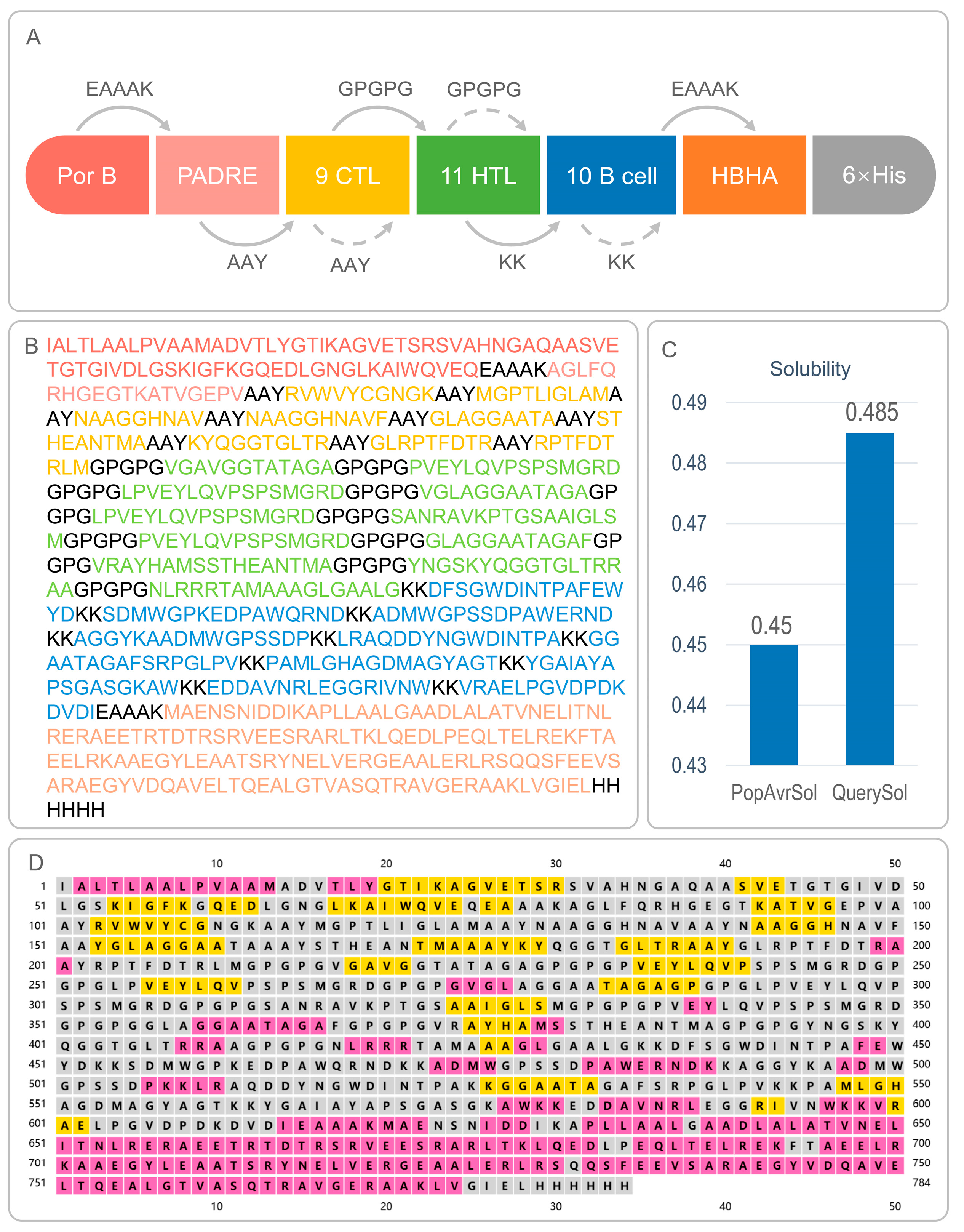
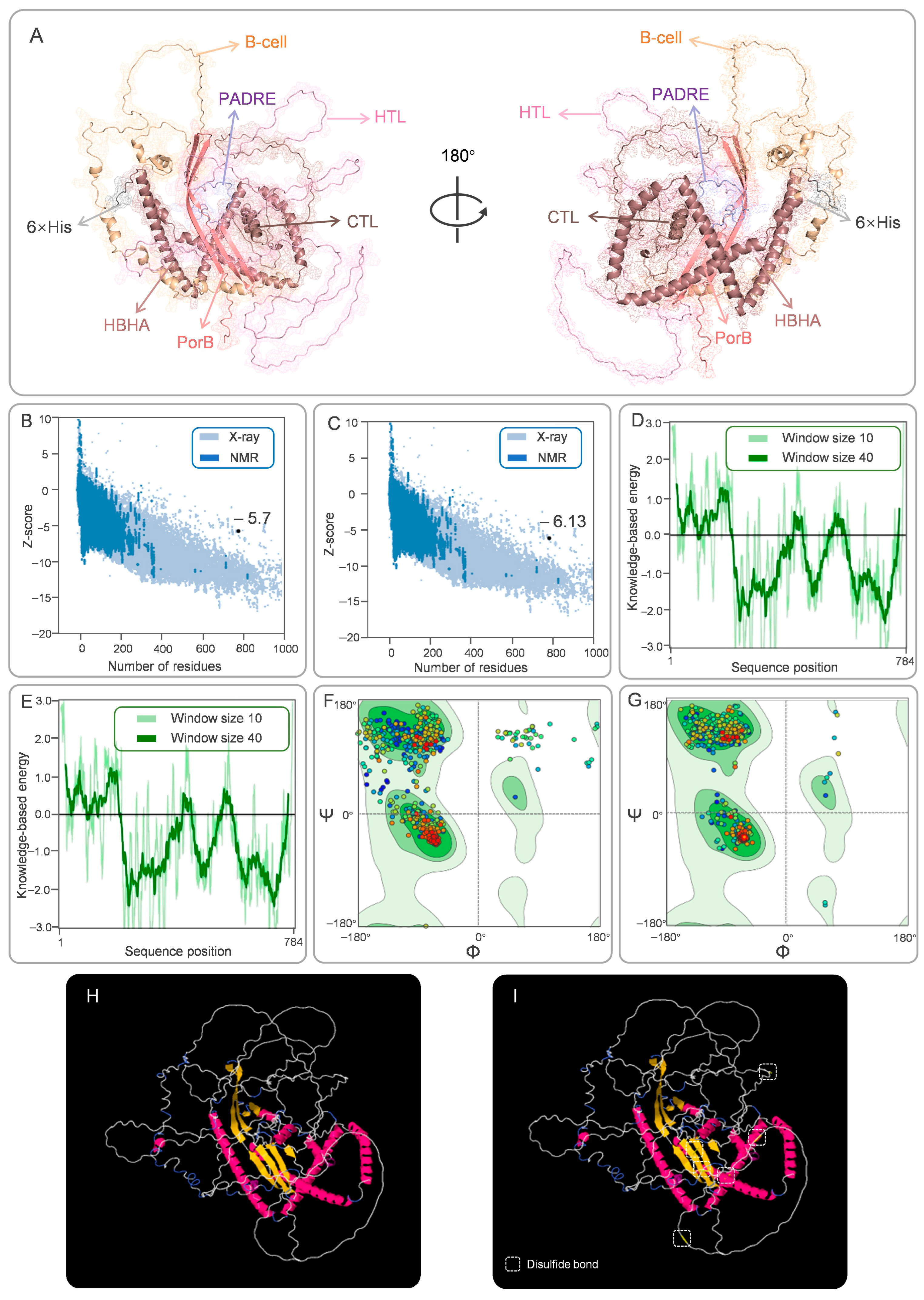
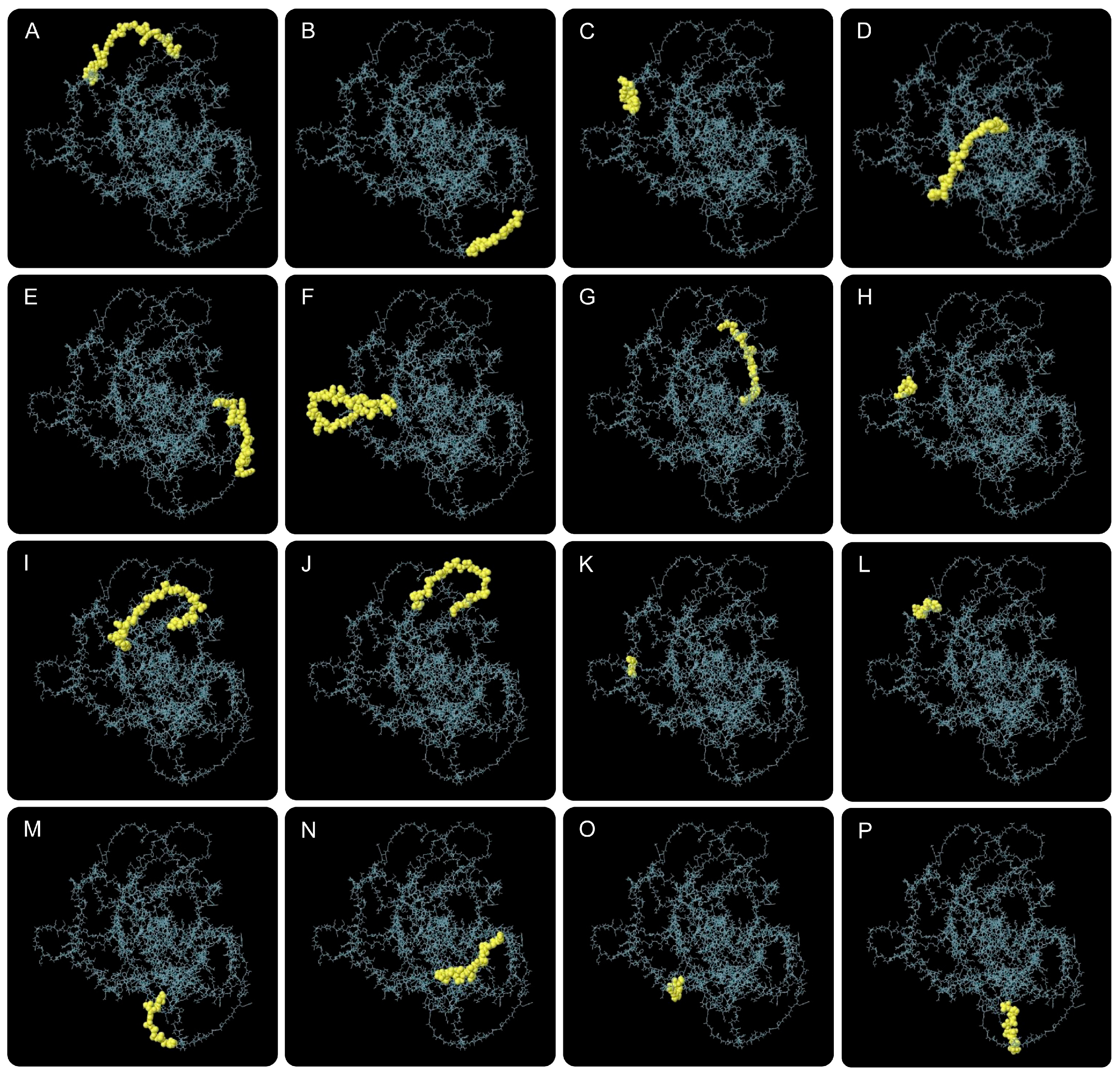
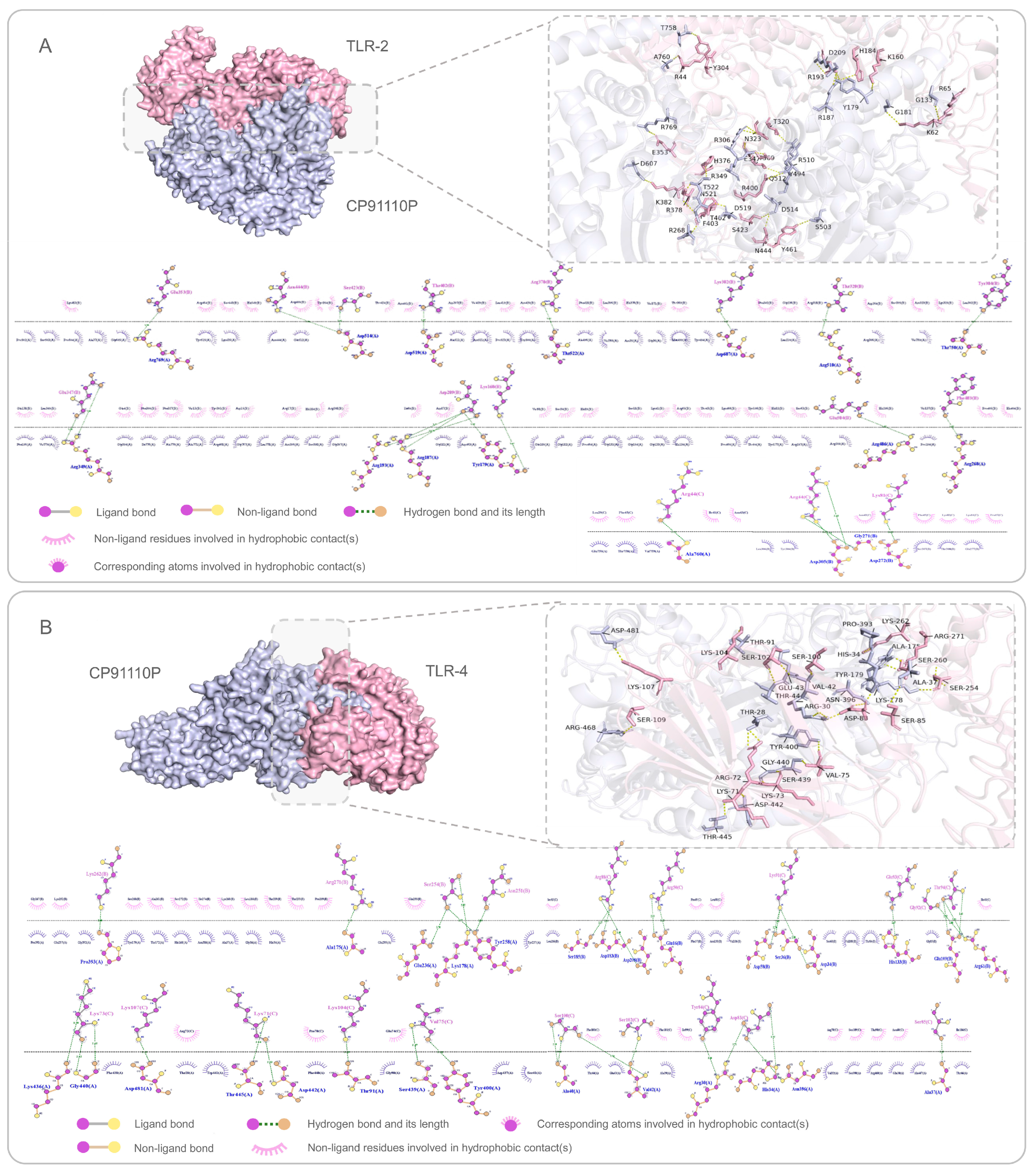

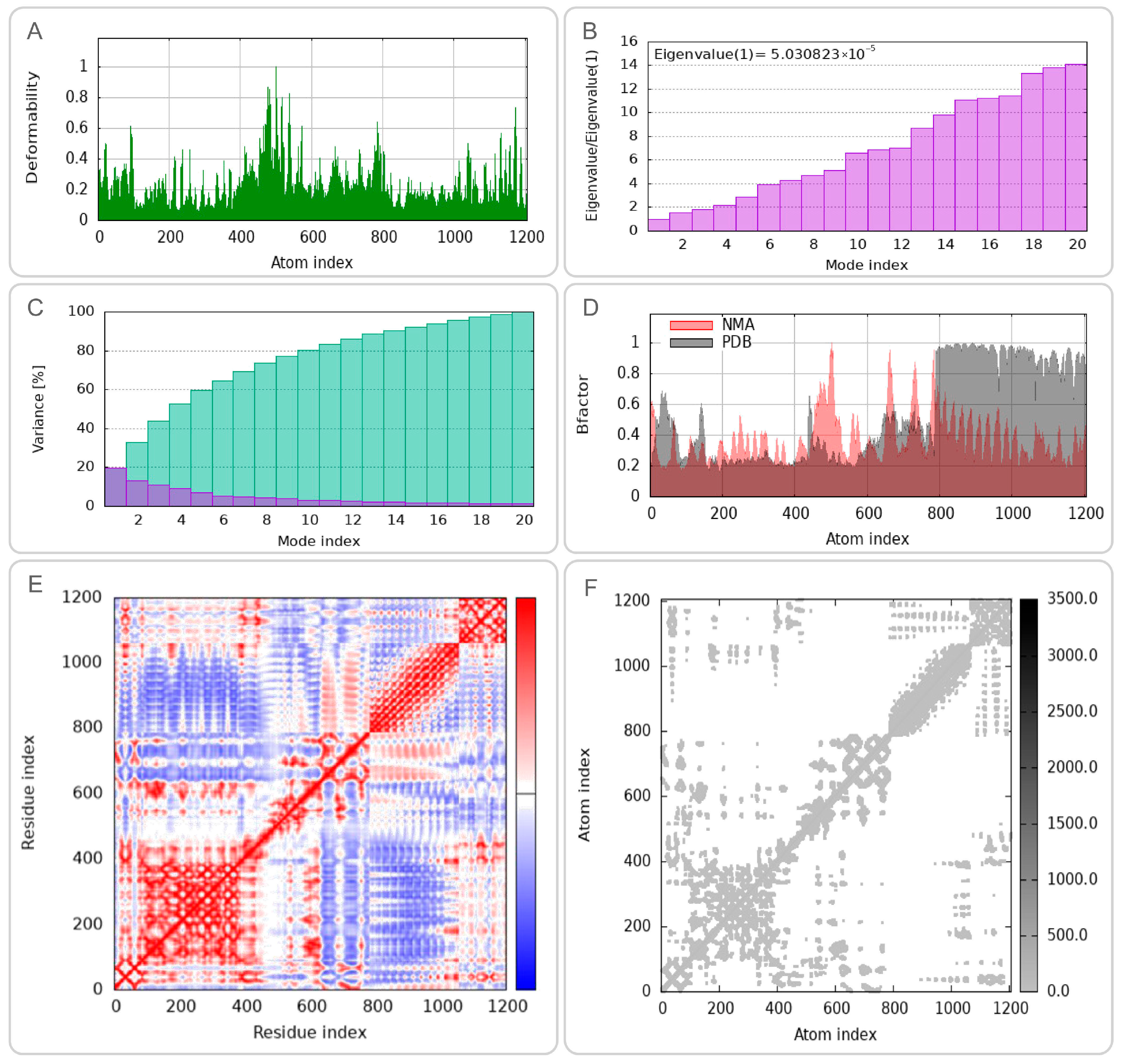
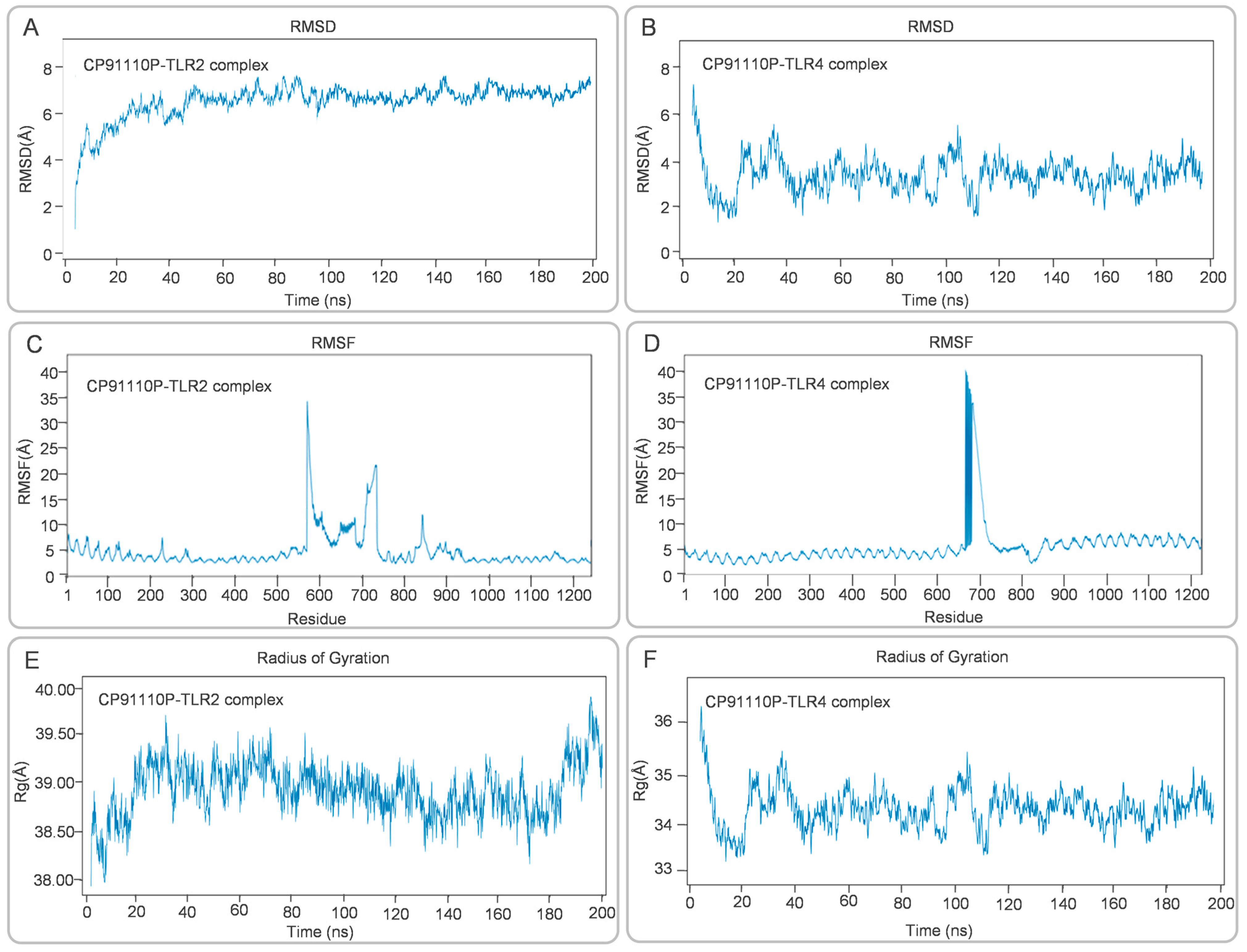
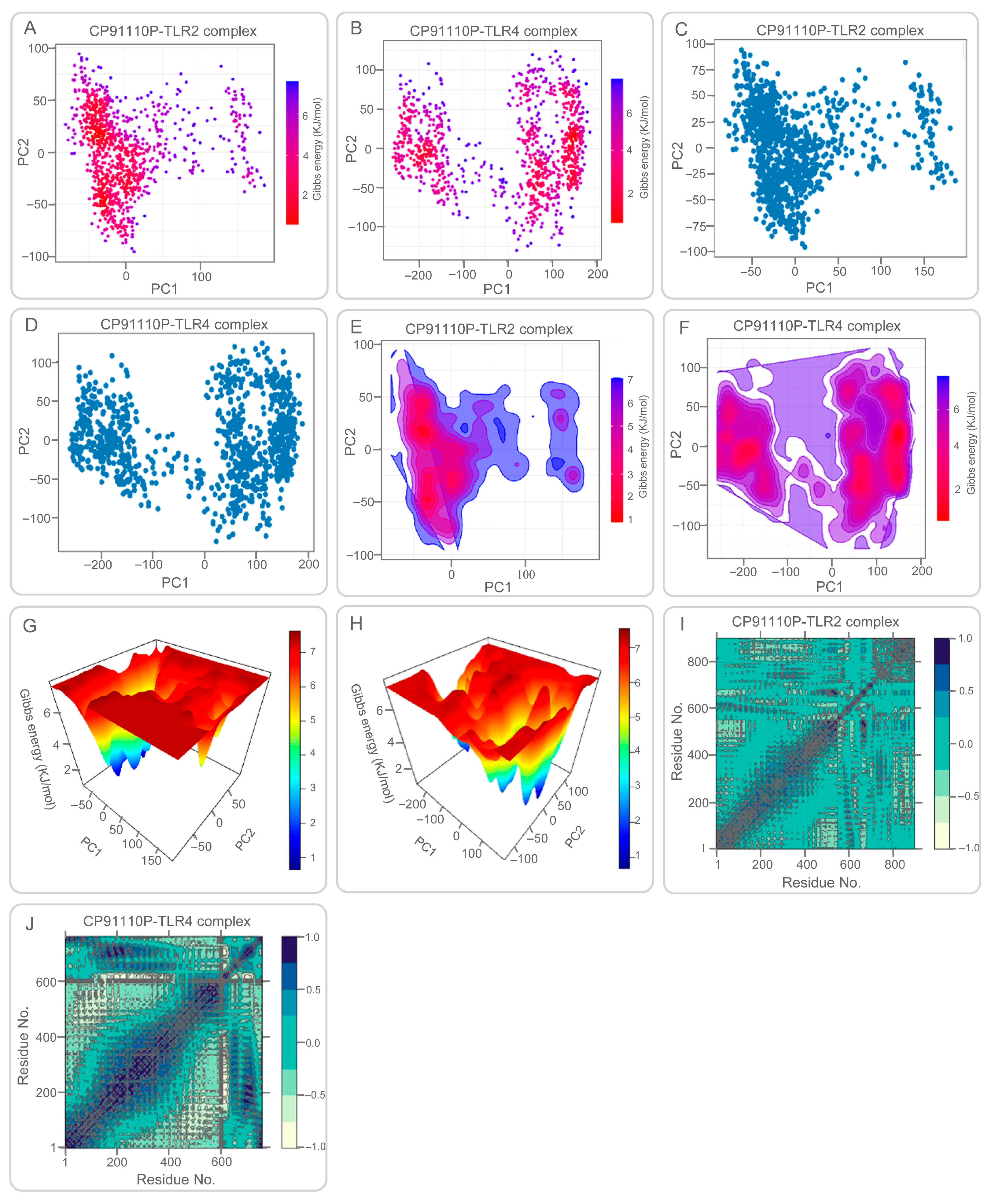
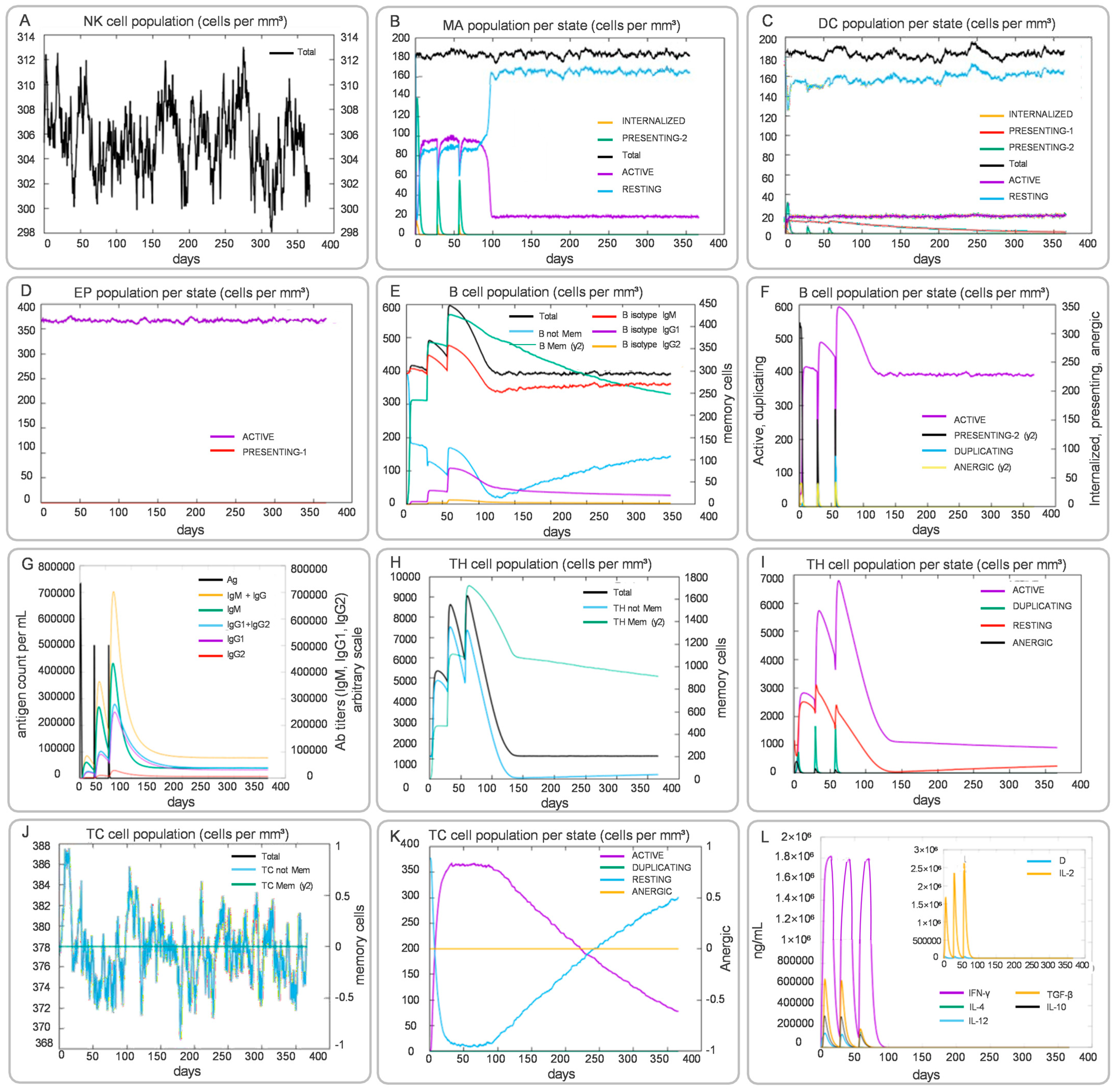
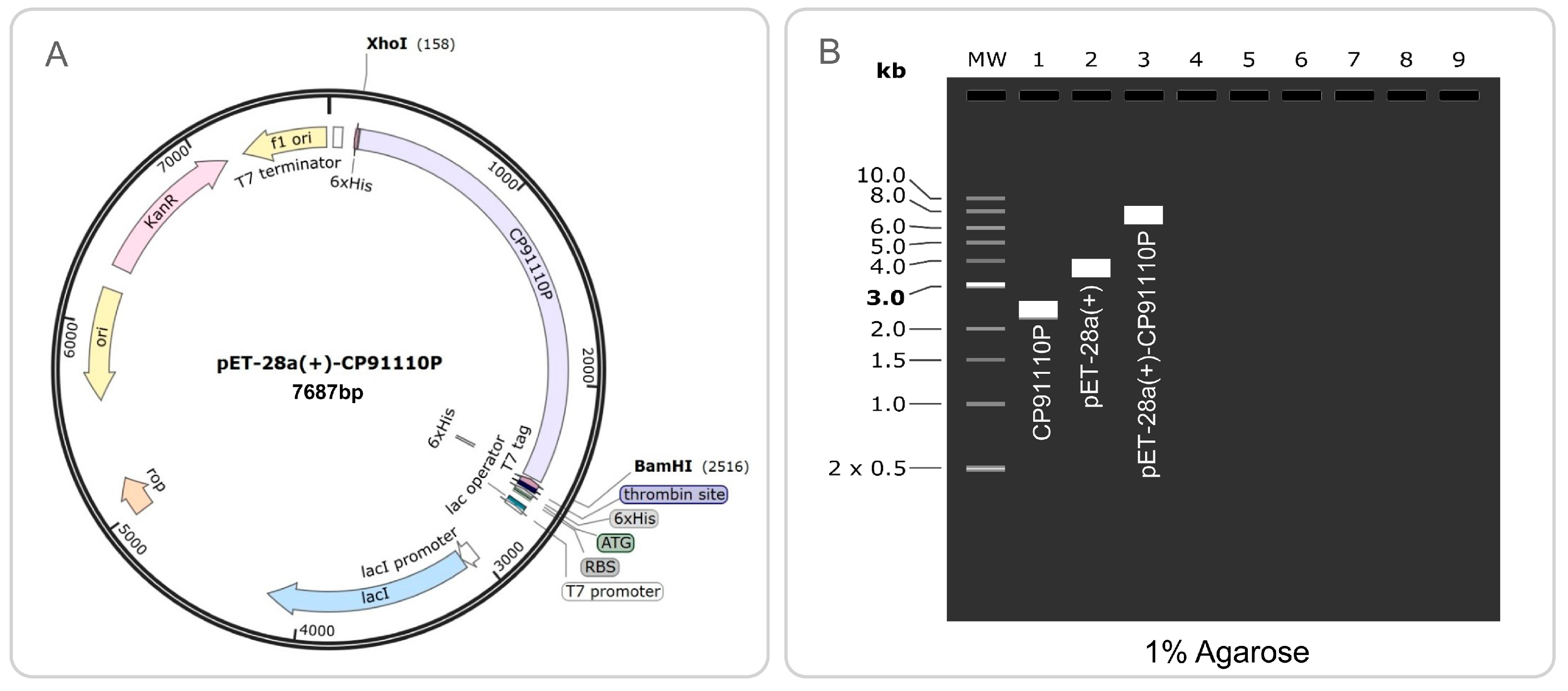
| Protein | Peptide Sequence | Length | Alleles | Percentile Rank a | Antigenicity Score b | IFN-γ Score c | Immunogenicity Score d | ABCpred Score e | Allergen FPv.2.0 f | Toxin Pred f | IL-4 g | IL-10 h |
|---|---|---|---|---|---|---|---|---|---|---|---|---|
| HTL epitopes | ||||||||||||
| Ag85A | VGAVGGTATAGA | 12 | HLA-DQA1*05:01/DQB1*03:01 | 0.27 | 1.588 | 0.56383711 | N/A | N/A | Non | Non | Non | Non |
| PVEYLQVPSPSMGRD | 15 | HLA-DRB1*07:01 | 0.32 | 0.7094 | 0.99952242 | N/A | N/A | Non | Non | Non | Non | |
| LPVEYLQVPSPSMGRD | 16 | HLA-DRB1*07:01 | 0.43 | 0.9243 | 0.7434204 | N/A | N/A | Non | Non | Non | Non | |
| Ag85B | VGLAGGAATAGA | 12 | HLA-DQA1*05:01/DQB1*03:01 | 0.06 | 1.2823 | 0.70650331 | N/A | N/A | Non | Non | Non | Non |
| LPVEYLQVPSPSMGRD | 16 | HLA-DRB1*07:01 | 0.43 | 0.9243 | 0.7434204 | N/A | N/A | Non | Non | Non | Non | |
| SANRAVKPTGSAAIGLSM | 18 | HLA-DRB1*07:01 | 0.21 | 0.7624 | 0.94857343 | N/A | N/A | Non | Non | Non | Non | |
| PVEYLQVPSPSMGRD | 15 | HLA-DRB1*07:01 | 0.32 | 0.7094 | 0.99952242 | N/A | N/A | Non | Non | Non | Non | |
| GLAGGAATAGAF | 12 | HLA-DQA1*05:01/DQB1*03:01 | 0.33 | 0.9538 | 0.62913663 | N/A | N/A | Non | Non | Non | Non | |
| Rv0288 | VRAYHAMSSTHEANTMA | 17 | HLA-DRB1*04:05 | 0.12 | 0.8572 | 0.76415085 | N/A | N/A | Non | Non | Non | Non |
| Rv1813c | YNGSKYQGGTGLTRRAA | 17 | HLA-DRB5*01:01 | 0.42 | 1.2302 | 0.14674751 | N/A | N/A | Non | Non | Non | Non |
| NLRRRTAMAAAGLGAALG | 18 | HLA-DPA1*02:01/DPB1*14:01 | 0.48 | 0.6188 | 0.92377101 | N/A | N/A | Non | Non | Non | Non | |
| CTL epitopes | ||||||||||||
| Ag85A | RVWVYCGNGK | 10 | HLA-A*03:01 | 0.42 | 0.7151 | N/A | 0.10358 | N/A | Non | Non | N/A | N/A |
| MGPTLIGLAM | 10 | HLA-B*35:01 | 0.23 | 0.524 | N/A | 0.19966 | N/A | Non | Non | N/A | N/A | |
| 10 | HLA-B*07:02 | 0.47 | ||||||||||
| Ag85B | NAAGGHNAV | 9 | HLA-A*68:02 | 0.2 | 1.9957 | N/A | 0.12765 | N/A | Non | Non | N/A | N/A |
| NAAGGHNAVF | 10 | HLA-B*35:01 | 0.33 | 1.4758 | N/A | 0.16235 | N/A | Non | Non | N/A | N/A | |
| GLAGGAATA | 9 | HLA-A*02:03 | 0.13 | 1.3338 | N/A | 0.17233 | N/A | Non | Non | N/A | N/A | |
| Rv0288 | STHEANTMA | 9 | HLA-A*68:02 | 0.34 | 0.9084 | N/A | 0.07342 | N/A | Non | Non | N/A | N/A |
| Rv1813c | KYQGGTGLTR | 10 | HLA-A*31:01 | 0.24 | 1.3245 | N/A | 0.11252 | N/A | Non | Non | N/A | N/A |
| Rv2031c | GLRPTFDTR | 9 | HLA-A*31:01 | 0.14 | 1.7146 | N/A | 0.19504 | N/A | Non | Non | N/A | N/A |
| RPTFDTRLM | 9 | HLA-B*07:02 | 0.09 | 1.3402 | N/A | 0.22574 | N/A | Non | Non | N/A | N/A | |
| 9 | HLA-B*35:01 | 0.41 | ||||||||||
| B cellular epitopes | ||||||||||||
| Ag85A | DFSGWDINTPAFEWYD | 16 | N/A | N/A | N/A | N/A | N/A | 0.9 | Non | Non | N/A | N/A |
| SDMWGPKEDPAWQRND | 16 | N/A | N/A | N/A | N/A | N/A | 0.9 | Non | Non | N/A | N/A | |
| Ag85B | ADMWGPSSDPAWERND | 16 | N/A | N/A | N/A | N/A | N/A | 0.9 | Non | Non | N/A | N/A |
| AGGYKAADMWGPSSDP | 16 | N/A | N/A | N/A | N/A | N/A | 0.88 | Non | Non | N/A | N/A | |
| LRAQDDYNGWDINTPA | 16 | N/A | N/A | N/A | N/A | N/A | 0.85 | Non | Non | N/A | N/A | |
| GGAATAGAFSRPGLPV | 16 | N/A | N/A | N/A | N/A | N/A | 0.85 | Non | Non | N/A | N/A | |
| Rv0288 | PAMLGHAGDMAGYAGT | 16 | N/A | N/A | N/A | N/A | N/A | 0.85 | Non | Non | N/A | N/A |
| Rv1813c | YGAIAYAPSGASGKAW | 16 | N/A | N/A | N/A | N/A | N/A | 0.92 | Non | Non | N/A | N/A |
| EDDAVNRLEGGRIVNW | 16 | N/A | N/A | N/A | N/A | N/A | 0.85 | Non | Non | N/A | N/A | |
| Rv2031c | VRAELPGVDPDKDVDI | 16 | N/A | N/A | N/A | N/A | N/A | 0.88 | Non | Non | N/A | N/A |
| Population/Area | Class Combined | ||
|---|---|---|---|
| Coverage a | Average_Hit b | pc90 c | |
| Central Africa | 81.63% | 3.43 | 0.54 |
| Central America | 87.71% | 4.04 | 0.81 |
| East Africa | 83.67% | 3.55 | 0.61 |
| East Asia | 75.12% | 2.81 | 0.4 |
| Europe | 87.68% | 4.55 | 0.81 |
| North Africa | 78.89% | 4.02 | 0.47 |
| North America | 90.28% | 5.1 | 1.09 |
| Northeast Asia | 78.68% | 3.23 | 0.47 |
| Oceania | 79.98% | 3.28 | 0.5 |
| South Africa | 37.00% | 0.8 | 0.16 |
| South America | 91.34% | 4.49 | 1.15 |
| South Asia | 83.97% | 3.98 | 0.62 |
| Southeast Asia | 68.83% | 2.58 | 0.32 |
| Southwest Asia | 75.59% | 3.38 | 0.41 |
| West Africa | 97.85% | 5.86 | 3.02 |
| West Indies | 79.97% | 3.9 | 0.5 |
| World | 86.18% | 4.17 | 0.72 |
| Average | 80.26 | 3.72 | 0.74 |
| Standard deviation | 12.47 | 1.07 | 0.62 |
| Parameters | Results | |
|---|---|---|
| Biological characteristics | Antigenicity | 0.8789 a |
| 0.801088 b | ||
| Immunogenicity | 4.40091 | |
| Sensitization | Non | |
| Toxicity | Non | |
| Physicochemical properties | Number of amino acids | 784 |
| Molecular weight(Da) | 80,722.29 | |
| Theoretical pI | 7.38 | |
| Estimated half-life (h) c | Mammalian reticulocytes (in vitro) | 20 |
| Yeast (in vivo) | 0.5 | |
| E. coli (in vivo) | >10 | |
| Instability index | 33.48 | |
| Aliphatic index | 66.07 | |
| Grand average of hydropathicity (GRAVY) | 33.48 | |
| Basic features | Solubility | 0.485 |
| Component | CP91110P–TLR2 (kcal/mol) | CP91110P–TLR4 (kcal/mol) |
|---|---|---|
| ΔEvdw (van der Waals) | −40.8 | −35.6 |
| ΔEele (Electrostatic) | −120.3 | −105.7 |
| ΔGPB (Polar solvation) | 110.8 | 102.4 |
| ΔGSA (Non-polar solvation) | −9.2 | −7.8 |
| ΔGbind Total | −59.5 | −46.7 |
| Component | CP91110P–TLR2 (kcal/mol) | CP91110P–TLR4 (kcal/mol) |
|---|---|---|
| ΔEvdw (van der Waals) | −40.8 | −35.6 |
| ΔEele (Electrostatic) | −120.3 | −105.7 |
| ΔGGB (Polar solvation) | 102.5 | 95.3 |
| ΔGSA (Non-polar solvation) | −9.2 | −7.8 |
| ΔGbind Total | −67.8 | −53.8 |
Disclaimer/Publisher’s Note: The statements, opinions and data contained in all publications are solely those of the individual author(s) and contributor(s) and not of MDPI and/or the editor(s). MDPI and/or the editor(s) disclaim responsibility for any injury to people or property resulting from any ideas, methods, instructions or products referred to in the content. |
© 2025 by the authors. Licensee MDPI, Basel, Switzerland. This article is an open access article distributed under the terms and conditions of the Creative Commons Attribution (CC BY) license (https://creativecommons.org/licenses/by/4.0/).
Share and Cite
An, Y.; Ali, S.L.; Liu, Y.; Abduldayeva, A.; Ni, R.; Li, Y.; Zhang, M.; Tian, Y.; Jiang, L.; Gong, W. CP91110P: A Computationally Designed Multi-Epitope Vaccine Candidate for Tuberculosis via TLR-2/4 Synergistic Immunomodulation. Biology 2025, 14, 1196. https://doi.org/10.3390/biology14091196
An Y, Ali SL, Liu Y, Abduldayeva A, Ni R, Li Y, Zhang M, Tian Y, Jiang L, Gong W. CP91110P: A Computationally Designed Multi-Epitope Vaccine Candidate for Tuberculosis via TLR-2/4 Synergistic Immunomodulation. Biology. 2025; 14(9):1196. https://doi.org/10.3390/biology14091196
Chicago/Turabian StyleAn, Yajing, Syed Luqman Ali, Yanhua Liu, Aigul Abduldayeva, Ruizi Ni, Yufeng Li, Mingming Zhang, Yuan Tian, Lina Jiang, and Wenping Gong. 2025. "CP91110P: A Computationally Designed Multi-Epitope Vaccine Candidate for Tuberculosis via TLR-2/4 Synergistic Immunomodulation" Biology 14, no. 9: 1196. https://doi.org/10.3390/biology14091196
APA StyleAn, Y., Ali, S. L., Liu, Y., Abduldayeva, A., Ni, R., Li, Y., Zhang, M., Tian, Y., Jiang, L., & Gong, W. (2025). CP91110P: A Computationally Designed Multi-Epitope Vaccine Candidate for Tuberculosis via TLR-2/4 Synergistic Immunomodulation. Biology, 14(9), 1196. https://doi.org/10.3390/biology14091196







